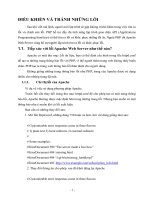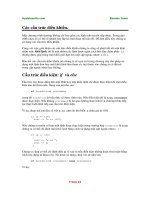ĐIỀU KHIỂN VÀ TRÁNH NHỮNG LỖI
Bạn đang xem bản rút gọn của tài liệu. Xem và tải ngay bản đầy đủ của tài liệu tại đây (372.72 KB, 24 trang )
ĐIỀU KHIỂN VÀ TRÁNH NHỮNG LỖI
Sau khi viết mã lệnh, người mới lập trình sẽ gặp không ít khó khăn trong việc tìm ra
lỗi và chỉnh sửa lỗi. PHP hỗ trợ đầy đủ tính năng lập trình giao diện API (Applications
Programming Interface) có thể tìm ra lỗi và khắc phục những lỗi ấy. Ngoài PHP thì Apache
Web Server cũng hỗ trợ người lập trình tìm ra lỗi và khắc phục lỗi.
1.1. Tiếp xúc với lỗi Apache Web Server như thế nào?
Apache có một thư mục Lỗi tài liệu, bạn có thể định cấu hình trong file httpd.conf
để tạo ra những trang thông báo lỗi với PHP, vì thế người thăm trang web không thấy buồn
chán. PHP tạo ra trang web thông báo lỗi thân thiện cho người dùng.
Không giống những trang thông báo lỗi như PHP, trang của Apache được sử dụng
nhiều cho những trang đã mất.
1.1.1. Chỉ thị lỗi của Apache
Ví dụ về việc sử dụng phương pháp Apache.
Trước hết cần thay đổi trong thư mục httpd.conf để cho phép tạo ra một trang thông
báo lỗi, Apache thường được mặc định bên trong những trang lỗi. Nhưng bạn muốn có một
thông báo như ý muốn khi có lỗi xuất hiện.
Bạn cần có những thay đổi sau:
1. Mở file httpd.conf, những dòng 750 hoặc xa hơn, tìm vài dòng giống như sau:
# Customizable error responses come in three flavors:
# 1) plain text 2) local redirects 3) external redirects
#
# Some examples:
#ErrorDocument 500 “The server made a boo boo.”
#ErrorDocument 404 /missing.html
#ErrorDocument 404 “/cgi-bin/missing_handler.pl”
#ErrorDocument 402 195H />2. Thay đổi thông tin cho phép sau đó khởi động lại Apache
# Customizable error responses come in three flavors:
- 1 -
# 1) plain text 2) local redirects 3) external redirects
#
# Some examples:
ErrorDocument 400 /error.php?400
ErrorDocument 401 /error.php?401
ErrorDocument 403 /error.php?403
ErrorDocument 404 /error.php?404
1ErrorDocument 500 /error.php?500
Nó hoạt động thế nào?
Bạn vừa soạn thảo cấu hình Apache để giúp bạn thi hành lỗi, bạn có thể gởi đến
người dùng những trang lỗi phụ thuộc vào những lỗi mà người dùng gặp phải
Có nhiều lỗi trong tài liệu nhưng chúng ta sẽ tập trung vào lỗi mà thường gặp hằng
ngày.
❑ 400: Lời thỉnh cầu không tốt
❑ 401:Yêu cầu được cho phép
❑ 403: Không được phép
❑ 404: Không tìm thấy
❑ 500: Lỗi từ server
Ví dụ: Hiển thị lỗi
Để hiển thị thông báo lỗi, bạn làm những bước sau:
1.Mở trình duyệt và lưu với tên error.php
2. Nhập những dòng sau:
<?php
$error_no = $_SERVER[‘QUERY_STRING’];
switch ($error_no)
{
case 400:
$error_output = “<h1>"Bad Request" Error
Page - “ .
- 2 -
“(Error Code 400)</h1>”;
$error_output .= “The browser has made a Bad
Request<br>”;
$error_output .= “<a
href=\”mailto:\”>” .
“Contact</a> the system administrator”;
$error_output .= “ if you feel this to be in error”;
break;
case 401:
$error_output = “<h1>"Authorization
Required" “ .
“Error Page - (Error Code 401)</h1>”;
$error_output .= “You have supplied the wrong
information to “ .
“access a secure area<br>”;
$error_output .= “<a
href=\”mailto:\”>” .
“Contact</a> the system administrator”;
$error_output .= “ if you feel this to be in error”;
break;
case 403:
$error_output = “<h1>"Forbidden Access"
Error Page - “ .
“(Error Code 403)</h1>”;
$error_output .= “You are denied access to this
area<br>”;
$error_output .= “<a
href=\”mailto:\”>” .
“Contact</a> the system administrator”;
$error_output .= “ if you feel this to be in error”;
break;
- 3 -
case 404:
$error_output = “<h1>"Page Not Found"
Error Page - “ .
“(Error Code 404)</h1>”;
$error_output .= “The page you are looking for cannot “
.
“be found<br>”;
$error_output .= “<a
href=\”mailto:\”>” .
“Contact</a> the system administrator”;
$error_output .= “ if you feel this to be in error”;
break;
case 500:
$error_output = “<h1>"Internal Server
Error" “ .
“Error Page – (Error Code 500)</h1>”;
$error_output .= “The server has encountered an
internal “ .
“error<br>”;
$error_output .= “<a
href=\”mailto:\”>” .
“Contact</a> the system administrator”;
$error_output .= “ if you feel this to be in error”;
break;
default:
$error_output = “<h1>Error Page</h1>”;
$error_output .= “This is the custom error Page<br>”;
$error_output .= “You should be <a
href=\”index.php\”>here</a>”;
}
?>
- 4 -
<html>
<head>
<title>Beginning PHP5, Apache, MySQL Web Development</title>
</head>
<body>
<?php
echo $error_output;
?>
</body>
</html>
3.Mở trình duyệt và vào 196Hhttp://localhost/asdf/qwerty/page.html hoặc bất kỳ trang
web nào mà bạn biết là không thể vào thăm trang web, bạn sẽ nhìn thấy như hình 9.1
Hình 9
1. Cách khác để kiểm tra rằng đoạn mã của bạn được ứng dụng vào
trong trang web với chuỗi thông tin truy vấn cho người dùng. Ví dụ
mở trình duyệt với tên 197Hhttp://localhost/error.php?500 , trang
sẽ sử dụng truy vấn và chạy đoạn mã nếu có lỗi nó sẽ xuất
hiện như hình sau ( giống hình trước).
- 5 -
Hình 9.2
Nó hoạt động thế nào?
Bạn vừa tạo ra những thông báo lỗi thường gặp, bằng việc sử dụng switch(), bạn có thể
hiển thị thích hợp những thông báo lỗi cần thiết cho người dùng.
1.1.2. Lỗi tài liệu của Apache: Trang báo lỗi thông thường
Bạn chỉ cho người dùng nhìn thấy những lỗi thông thường, mặc dù bạn có thể làm
nhiều hơn thế, đây là cách tốt để bạn theo dõi những trang mà bạn không thể kiểm tra định
kỳ được.
Ví dụ tạo một E_mail lỗi
Trong bài tập này, bạn tạo ra một email phát sinh tự động gởi đến người quản trị thời
gian xuất hiện lỗi, vào ngày nào, lỗi gì, trang nào phát sinh lỗi và thông báo lỗi nào được
hiển thị cho người dùng định hướng.
1. Mở file error.php, thay đổi như sau:
2. Nhập vào đoạn mã sau:
<?php
function email_admin($error_no,
$error_output,
$full_date,
$full_time,
$request_page)
{
$to = “Administrator <>”;
- 6 -
$subject = “Apache Error Generation”;
$body = “<html>”;
$body .= “<head>”;
$body .= “<title>Apache Error</title>”;
$body .= “</head>”;
$body .= “<body>”;
$body .= “Error occurred on <b>” . $full_date . “</b> “ .
“at <b>” . $full_time . “</b><br>”;
$body .= “Error received was a <b>” . $error_no . “</b> error.<br>”;
$body .= “The page that generated the error was: <b>” .
$request_page . “</b><br>”;
$body .= “The generated error message was:” . $error_output;
$body .= “</body>”;
$body .= “</html>”;
$headers = “MIME-Version: 1.0\r\n”;
$headers .= “Content-type: text/html; charset=iso-8859-1\r\n”;
$headers .= “From: Apache Error <>\r\n”;
$headers .= “Cc: \r\n”;
mail($to, $subject, $body, $headers);
}
$date = getdate();
$full_date = $date[‘weekday’] . “, “ .
$date[‘month’] . “ “ .
$date[‘mday’] . “, “ .
$date[‘year’];
$full_time = $date[‘hours’] . “:” .
$date[‘minutes’] . “:” .
$date[‘seconds’] . “:” .
$date[‘year’];
$error_no = $_SERVER[‘QUERY_STRING’];
$request_page = $_SERVER[‘REQUEST_URI’];
- 7 -
switch ($error_no)
{
case 400:
$error_output = “<h1>\”Bad Request\” Error Page - “ .
“(Error Code 400)</h1>”;
$error_output .= “The browser has made a Bad Request<br>”;
$error_output .= “<a href=\”mailto:\”>” .
“Contact</a> the system administrator”;
$error_output .= “ if you feel this to be in error”;
email_admin($error_no,
$error_output,
$full_date,
$full_time,
$request_page);
break;
case 401:
$error_output = “<h1>\”Authorization Required\” Error Page - “ .
“(Error Code 401)</h1>”;
$error_output .= “You have supplied the wrong information to “ .
“access a secure area<br>”;
$error_output .= “<a href=\”mailto:\”>” .
“Contact</a> the system administrator”;
$error_output .= “ if you feel this to be in error”;
email_admin($error_no,
$error_output,
$full_date,
$full_time,
$request_page);
break;
case 403:
$error_output = “<h1>\”Forbidden Access\” Error Page - “ .
- 8 -
“(Error Code 403)</h1>”;
$error_output .= “You are denied access to this area<br>”;
$error_output .= “<a href=\”mailto:\”>” .
“Contact</a> the system administrator”;
$error_output .= “ if you feel this to be in error”;
email_admin($error_no,
$error_output,
$full_date,
$full_time,
$request_page);
break;
case 404:
$error_output = “<h1>\”Page Not Found\” Error Page - “ .
“(Error Code 404)</h1>”;
$error_output .= “The page you are looking for “ .
“cannot be found<br>”;
$error_output .= “<a href=\”mailto:\”>” .
“Contact</a> the system administrator”;
$error_output .= “ if you feel this to be in error”;
email_admin($error_no,
$error_output,
$full_date,
$full_time,
$request_page);
break;
case 500:
$error_output = “<h1>\”Internal Server Error\” Error Page - “ .
“(Error Code 500)</h1>”;
$error_output .= “The server has encountered “ .
“an internal error<br>”;
$error_output .= “<a href=\”mailto:\”>” .
- 9 -









